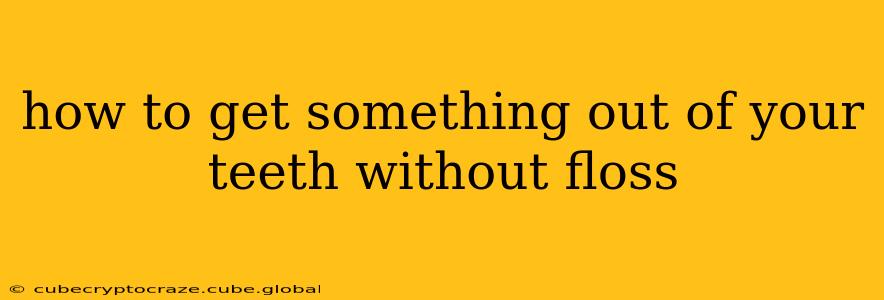How to Get Something Out of Your Teeth Without Floss: A Comprehensive Guide
Getting something stuck between your teeth is frustrating, especially when you don't have floss handy. Fortunately, there are several alternative methods you can try to dislodge that pesky food particle or other debris. This guide will walk you through safe and effective ways to deal with this common problem.
Important Note: While these methods offer alternatives to floss, regular flossing remains crucial for maintaining optimal oral hygiene. These techniques are for occasional use only.
What are some common household items that can be used to remove food stuck between your teeth?
Many household items can effectively remove trapped food particles. The key is to use a gentle, controlled approach to avoid damaging your teeth or gums. Some options include:
-
Toothpick: A wooden toothpick can be carefully inserted between your teeth to dislodge the trapped food. Important: Use a gentle, scraping motion, not a forceful jabbing motion. Avoid using excessive pressure, which can damage your gums. Discard the toothpick after use.
-
Interdental brush: These small brushes are designed specifically for cleaning between teeth and are gentler than toothpicks. They are available in various sizes to fit the gaps between your teeth.
-
Waterpik (or similar water flosser): A water flosser uses a stream of water to dislodge food particles and plaque. It’s a particularly effective option for those with braces or other dental appliances that make flossing difficult.
-
A blunt-ended tool: In a pinch, a clean, blunt-ended object like the rounded end of a butter knife (thoroughly cleaned!), or a clean, stiff piece of plastic can gently dislodge the food. Caution: Exercise extreme caution to prevent injury to your gums.
What if I'm using a toothpick? How do I do it correctly?
Using a toothpick correctly is crucial to prevent gum damage. Here's the proper technique:
- Choose a soft, wooden toothpick: Avoid plastic toothpicks, as they can be harder and more likely to injure your gums.
- Gently insert the toothpick: Use a slight scraping motion along the side of the tooth, avoiding forceful jabs.
- Remove the food: Carefully work the toothpick to dislodge the food particle.
- Rinse your mouth: Thoroughly rinse your mouth with water or mouthwash after removing the food.
- Discard the toothpick: Never reuse a toothpick.
What if nothing seems to work? What should I do?
If you've tried these methods and the food remains stuck, it’s best to see a dentist. They have the tools and expertise to remove the food safely and efficiently, preventing potential complications like infection or gum damage. Don't attempt to force anything out, as you risk injuring your gums or teeth.
Are there any long-term solutions to prevent food getting stuck in my teeth?
Preventing food from becoming trapped in the first place is the best solution! Consider these long-term strategies:
- Regular flossing: Flossing daily is the most effective way to prevent food from getting trapped between your teeth.
- Proper brushing technique: Brushing your teeth twice a day using the correct technique helps remove food particles and plaque.
- Healthy diet: A balanced diet can contribute to overall oral health.
- Regular dental checkups: Regular visits to your dentist can help identify and address potential issues early on.
By following these tips, you can effectively remove food from your teeth without floss while prioritizing the health of your gums and teeth. Remember, however, that these are temporary solutions; regular flossing and dental checkups are vital for maintaining optimal oral health.
